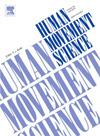行走平衡依赖视觉与脑瘫患者的体感功能有关
IF 1.9
3区 心理学
Q4 NEUROSCIENCES
引用次数: 0
摘要
目的探讨体感缺陷,特别是踝关节和髋关节位置感、两点辨别和振动对(1)行走时视觉扰动反应和(2)接受随机共振(SR)刺激后视觉扰动反应改善的关系。方法28名受试者(14名CP, 14名年龄和性别匹配的对照组)在一个虚拟现实洞穴中行走,同时受到视觉干扰。我们将SR应用于踝关节和髋关节。数据分析包括对每个感官测试的回归分析,以及使用所有四种感官测试作为预测因素的多元回归分析(MRA),以视觉扰动的反应和应用SR作为结果时反应的改善。结果感官测试的表现与视觉干扰的反应和sr的改善之间存在显著且强的相关性。MRA中只能输入一个预测因子,表明任何感官测试的表现都可以预测视觉干扰的反应和sr的改善。这项研究是鉴别CP患者对感觉治疗的潜在“应答者”的第一步。本文章由计算机程序翻译,如有差异,请以英文原文为准。

Reliance on vision for walking balance is related to somatosensory function in individuals with and without cerebral palsy
Aim
To investigate the relationship between somatosensory deficits, specifically ankle and hip joint position sense, two-point discrimination, and vibration on the (1) responses to visual perturbations during walking and (2) response improvements to visual perturbations while receiving a sensory-centric treatment, i.e., stochastic resonance (SR) stimulation, in individuals with and without cerebral palsy (CP).
Methods
Twenty-eight individuals (14 CP, 14 age-and sex-matched controls) walked in a virtual reality cave while receiving visual perturbations. We applied SR to the ankle and hip joints. Data analysis consisted of regression analyses for each sensory test as well as multiple regression analysis (MRA) using all four sensory tests as predictors with the responses to visual perturbation and the improvements in the responses when SR is applied as outcomes.
Results
We found significant and strong correlations between performance on sensory tests and the responses to visual perturbations, and improvements in the responses with SR. Only one predictor could be entered into the MRA, indicating that performance on any of the sensory tests could predict the responses to visual perturbation and the improvements with SR.
Interpretation
Individuals with sensory deficits are more responsive to sensory-centric interventions. This study is an initial step in identifying potential “responders” to sensory therapies in individuals with CP.
求助全文
通过发布文献求助,成功后即可免费获取论文全文。
去求助
来源期刊

Human Movement Science
医学-神经科学
CiteScore
3.80
自引率
4.80%
发文量
89
审稿时长
42 days
期刊介绍:
Human Movement Science provides a medium for publishing disciplinary and multidisciplinary studies on human movement. It brings together psychological, biomechanical and neurophysiological research on the control, organization and learning of human movement, including the perceptual support of movement. The overarching goal of the journal is to publish articles that help advance theoretical understanding of the control and organization of human movement, as well as changes therein as a function of development, learning and rehabilitation. The nature of the research reported may vary from fundamental theoretical or empirical studies to more applied studies in the fields of, for example, sport, dance and rehabilitation with the proviso that all studies have a distinct theoretical bearing. Also, reviews and meta-studies advancing the understanding of human movement are welcome.
These aims and scope imply that purely descriptive studies are not acceptable, while methodological articles are only acceptable if the methodology in question opens up new vistas in understanding the control and organization of human movement. The same holds for articles on exercise physiology, which in general are not supported, unless they speak to the control and organization of human movement. In general, it is required that the theoretical message of articles published in Human Movement Science is, to a certain extent, innovative and not dismissible as just "more of the same."
 求助内容:
求助内容: 应助结果提醒方式:
应助结果提醒方式:


